Transcription factor TFCP2L1 patterns cells in the mouse kidney collecting ducts
- PMID: 28577314
- PMCID: PMC5484618
- DOI: 10.7554/eLife.24265
Transcription factor TFCP2L1 patterns cells in the mouse kidney collecting ducts
Abstract
Although most nephron segments contain one type of epithelial cell, the collecting ducts consists of at least two: intercalated (IC) and principal (PC) cells, which regulate acid-base and salt-water homeostasis, respectively. In adult kidneys, these cells are organized in rosettes suggesting functional interactions. Genetic studies in mouse revealed that transcription factor Tfcp2l1 coordinates IC and PC development. Tfcp2l1 induces the expression of IC specific genes, including specific H+-ATPase subunits and Jag1. Jag1 in turn, initiates Notch signaling in PCs but inhibits Notch signaling in ICs. Tfcp2l1 inactivation deletes ICs, whereas Jag1 inactivation results in the forfeiture of discrete IC and PC identities. Thus, Tfcp2l1 is a critical regulator of IC-PC patterning, acting cell-autonomously in ICs, and non-cell-autonomously in PCs. As a result, Tfcp2l1 regulates the diversification of cell types which is the central characteristic of 'salt and pepper' epithelia and distinguishes the collecting duct from all other nephron segments.
Keywords: Jag1; Tfcp2l1; cell biology; collecting duct; developmental biology; intercalated cells; kidney; mouse; principal cells; stem cells.
Conflict of interest statement
The authors declare that no competing interests exist.
Figures
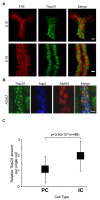
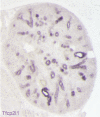
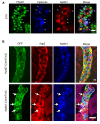
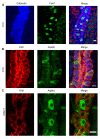

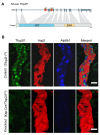

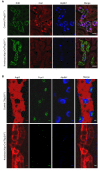
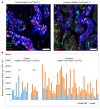

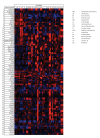

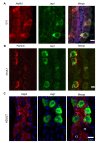
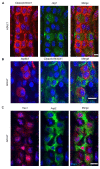









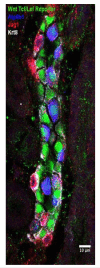
Similar articles
-
Elf5 is a principal cell lineage specific transcription factor in the kidney that contributes to Aqp2 and Avpr2 gene expression.Dev Biol. 2017 Apr 1;424(1):77-89. doi: 10.1016/j.ydbio.2017.02.007. Epub 2017 Feb 17. Dev Biol. 2017. PMID: 28215940 Free PMC article.
-
Endogenous Notch Signaling in Adult Kidneys Maintains Segment-Specific Epithelial Cell Types of the Distal Tubules and Collecting Ducts to Ensure Water Homeostasis.J Am Soc Nephrol. 2019 Jan;30(1):110-126. doi: 10.1681/ASN.2018040440. Epub 2018 Dec 4. J Am Soc Nephrol. 2019. PMID: 30514723 Free PMC article.
-
Transcriptomes of major renal collecting duct cell types in mouse identified by single-cell RNA-seq.Proc Natl Acad Sci U S A. 2017 Nov 14;114(46):E9989-E9998. doi: 10.1073/pnas.1710964114. Epub 2017 Oct 31. Proc Natl Acad Sci U S A. 2017. PMID: 29089413 Free PMC article.
-
The study of intercalated cells using ex vivo techniques: primary cell culture, cell lines, kidney slices, and organoids.Am J Physiol Cell Physiol. 2024 Jan 1;326(1):C229-C251. doi: 10.1152/ajpcell.00479.2022. Epub 2023 Oct 30. Am J Physiol Cell Physiol. 2024. PMID: 37899748 Review.
-
Development and Diseases of the Collecting Duct System.Results Probl Cell Differ. 2017;60:165-203. doi: 10.1007/978-3-319-51436-9_7. Results Probl Cell Differ. 2017. PMID: 28409346 Free PMC article. Review.
Cited by
-
Human ureteric bud organoids recapitulate branching morphogenesis and differentiate into functional collecting duct cell types.Nat Biotechnol. 2023 Feb;41(2):252-261. doi: 10.1038/s41587-022-01429-5. Epub 2022 Aug 29. Nat Biotechnol. 2023. PMID: 36038632 Free PMC article.
-
Connecting tubules develop from the tip of the ureteric bud in the human kidney.Histochem Cell Biol. 2021 Dec;156(6):555-560. doi: 10.1007/s00418-021-02033-5. Epub 2021 Sep 23. Histochem Cell Biol. 2021. PMID: 34554322
-
SMARCB1 regulates a TFCP2L1-MYC transcriptional switch promoting renal medullary carcinoma transformation and ferroptosis resistance.Nat Commun. 2023 May 26;14(1):3034. doi: 10.1038/s41467-023-38472-y. Nat Commun. 2023. PMID: 37236926 Free PMC article.
-
The Cellular and Molecular Landscape of Synchronous Pediatric Sialoblastoma and Hepatoblastoma.Front Oncol. 2022 Jul 4;12:893206. doi: 10.3389/fonc.2022.893206. eCollection 2022. Front Oncol. 2022. PMID: 35860547 Free PMC article.
-
Mutations in PRDM15 Are a Novel Cause of Galloway-Mowat Syndrome.J Am Soc Nephrol. 2021 Mar;32(3):580-596. doi: 10.1681/ASN.2020040490. Epub 2021 Feb 16. J Am Soc Nephrol. 2021. PMID: 33593823 Free PMC article.
References
-
- Aigner J, Kloth S, Jennings ML, Minuth WW. Transitional differentiation patterns of principal and intercalated cells during renal collecting duct development. Epithelial Cell Biology. 1995;4:121–130. - PubMed
-
- Aue A, Hinze C, Walentin K, Ruffert J, Yurtdas Y, Werth M, Chen W, Rabien A, Kilic E, Schulzke JD, Schumann M, Schmidt-Ott KM. A Grainyhead-Like 2/Ovo-Like 2 pathway regulates renal epithelial barrier function and lumen expansion. Journal of the American Society of Nephrology. 2015;26:2704–2715. doi: 10.1681/ASN.2014080759. - DOI - PMC - PubMed
MeSH terms
Substances
Grants and funding
LinkOut - more resources
Full Text Sources
Other Literature Sources
Molecular Biology Databases
Research Materials

